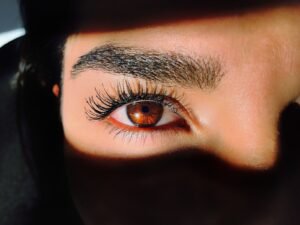The Fascinating World of Eye Colors
The world is filled with an array of captivating eye colors, each one unique in its own way. From the deep browns to the mesmerizing blues, and the enchanting greens to the mysterious hazels, eye colors have long been a subject of fascination and intrigue. In this article, we will explore the various eye colors that exist, their origins, and the rare occurrences that make them even more alluring. So, let’s delve into the captivating world of eye colors and unlock the secrets behind their beauty.

Brown Eyes: Most Common Eye Color Worldwide
Brown eyes, often referred to as the universal eye color, are the most commonly found color worldwide. This rich and warm hue is a result of high levels of melanin, a pigment responsible for the coloration of our eyes. Brown eyes can vary in shades, ranging from deep chocolate to lighter shades of amber. This eye color is more predominant in individuals with African, Asian, and Latin American descent, but it can be found in people from all ethnic backgrounds.

Blue Eyes: Unique and Mesmerizing Hues
Blue eyes are often associated with a sense of mystery and intrigue. This captivating eye color is caused by a lack of melanin in the iris, resulting in a translucent appearance that reflects light differently. The blue color we perceive is actually an optical illusion, as the iris itself does not contain any blue pigments. Blue eyes are more commonly found in individuals of European descent, particularly those with Northern European heritage. However, they can also occur sporadically in individuals from other ethnic backgrounds.
Green Eyes: Enchanting Shades and Origins
Green eyes are a rarity in the world, making up only about 2% of the global population. This eye color is considered one of the most enchanting and captivating due to its unique combination of blue and yellow pigments. Green eyes are caused by a moderate amount of melanin combined with a scattering of light in the iris. They are most commonly found in individuals with Celtic or Nordic ancestry, but they can also be found in people from other ethnic backgrounds, albeit less frequently.

Hazel Eyes: Mysterious and Multi-tonal
Hazel eyes are known for their intriguing mix of different colors, ranging from green, brown, and even hints of gold or amber. This captivating eye color is a result of a combination of melanin levels and the scattering of light. Hazel eyes are often described as being multi-tonal, as they can appear to change color depending on lighting conditions or even the individual’s emotions. This eye color is more commonly found in individuals of European, Middle Eastern, and Latin American descent.
Gray Eyes: Rare and Strikingly Beautiful
Gray eyes are a rare gem among eye colors, with only a small percentage of the population possessing this striking hue. The gray color is caused by low levels of melanin in the iris, resulting in a muted and ethereal appearance. Gray eyes can range from a light silver-gray to a darker charcoal-gray shade. This eye color is more commonly found in individuals of European descent, particularly those with Scandinavian or Slavic heritage.

Amber Eyes: A Rare Gem among Eye Colors
Amber eyes are a captivating and rare eye color that is often associated with a warm and golden appearance. This unique hue is caused by a higher concentration of yellow and orange pigments in the iris, giving the eyes their distinctive amber shade. Amber eyes are most commonly found in individuals with Asian, South American, or Native American ancestry. Their rarity and warmth make them highly sought after and admired.

Violet Eyes: Myth or Reality?
Violet eyes, often considered the stuff of legends, are a topic of fascination and debate. While true violet eyes are extremely rare, there have been a few reported cases of individuals possessing this extraordinary eye color. Violet eyes are believed to be the result of a low concentration of melanin combined with light reflection and refraction. However, it is essential to note that many instances of violet eyes are often misidentified shades of blue or gray. So, while violet eyes may exist, they are indeed a mythical rarity.

Black Eyes: The Deepest Shade of All
Black eyes, also known as dark brown eyes, encompass the deepest and darkest shades of eye color. This eye color is caused by a high concentration of melanin in the iris, resulting in a rich and intense hue. Black eyes are most commonly found in individuals of African, Asian, and Indigenous American descent. Their depth and intensity add an air of mystery and allure to those who possess them.
Red Eyes: The Unusual Phenomenon Explained
Red eyes, although not a natural eye color, can occur due to a rare condition called ocular albinism. Ocular albinism is a genetic disorder that affects the production of melanin in the eyes, resulting in a lack of pigmentation. This absence of pigmentation causes the blood vessels in the eyes to be more visible, giving the appearance of red or pink eyes. It is important to note that red eyes can also be a result of certain medical conditions or the use of certain medications.

Heterochromia: When Eyes Have Different Colors
Heterochromia is a fascinating phenomenon where an individual’s eyes have different colors. This condition can be present from birth or acquired later in life. Heterochromia occurs due to an imbalance in the distribution of melanin in the iris, resulting in each eye having a different hue. This striking contrast can range from a subtle difference in shade to a distinct and noticeable difference in color. Heterochromia can add an element of uniqueness and intrigue to an individual’s appearance.

Eye Color Changes: Natural or Artificial Transformations
While eye color is primarily determined by genetics and remains relatively stable throughout a person’s life, there are rare cases of eye color changes. Natural changes in eye color can occur due to aging, hormonal fluctuations, or certain medical conditions. Additionally, advancements in medical technology have made it possible to change eye color through artificial means, such as the use of colored contact lenses or surgical procedures. However, it is important to note that altering eye color should be done under the guidance of a qualified professional to ensure safety and minimize potential risks.
Unlocking the Beauty of Eye Colors
The captivating world of eye colors holds a plethora of beauty, diversity, and intrigue. From the most common brown eyes to the rare and mythical violet eyes, each eye color tells a unique story. Whether we possess a warm brown, a mesmerizing blue, or an enchanting green, our eyes are a window to our soul and a reflection of our genetic heritage. So, let us embrace the diversity and beauty of eye colors and appreciate the fascinating world they unveil.
